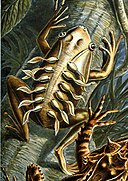Fil:Haeckel Batrachia.jpg

Storlek på förhandsvisningen: 424 × 599 pixlar. Andra upplösningar: 170 × 240 pixlar | 339 × 480 pixlar | 543 × 768 pixlar | 724 × 1 024 pixlar | 2 323 × 3 284 pixlar.
Originalfil (2 323 × 3 284 pixlar, filstorlek: 2,17 Mbyte, MIME-typ: image/jpeg)
Filhistorik
Klicka på ett datum/klockslag för att se filen som den såg ut då.
| Datum/Tid | Miniatyrbild | Dimensioner | Användare | Kommentar | |
|---|---|---|---|---|---|
| nuvarande | 24 februari 2006 kl. 05.17 |  | 2 323 × 3 284 (2,17 Mbyte) | Ragesoss | improve version, based on same original scan |
| 11 februari 2006 kl. 02.22 |  | 2 318 × 3 280 (2,21 Mbyte) | Ragesoss | The 68th plate from Ernst Haeckel's 1899 ''Kunstformen der Natur'', depicting frogs classified as Batrachia. Category:Ernst Haeckel |
Filanvändning
Följande 3 sidor använder den här filen:
Global filanvändning
Följande andra wikier använder denna fil:
- Användande på arz.wikipedia.org
- Användande på ast.wikipedia.org
- Användande på az.wikipedia.org
- Användande på ban.wikipedia.org
- Användande på be.wikipedia.org
- Användande på bg.wikipedia.org
- Användande på ca.wikipedia.org
- Användande på ca.wikibooks.org
- Användande på ceb.wikipedia.org
- Användande på ckb.wikipedia.org
- Användande på dag.wikipedia.org
- Användande på de.wikipedia.org
- Användande på din.wikipedia.org
- Användande på el.wikipedia.org
- Användande på en.wikipedia.org
- Wikipedia:Featured pictures thumbs/04
- Wikipedia:Picture of the day/June 2006
- User:Ragesoss/Haeckel
- Wikipedia:Featured picture candidates/Haeckel Batrachia.jpg
- Wikipedia:Wikipedia Signpost/2006-03-13/Features and admins
- Wikipedia:Featured picture candidates/March-2006
- Talk:Frog/Archive 3
- User talk:Ragesoss/Archive1
- Wikipedia:Picture of the day/June 12, 2006
- Wikipedia:POTD/June 12, 2006
- Wikipedia:POTD column/June 12, 2006
- Wikipedia:POTD row/June 12, 2006
- Kunstformen der Natur
- User:Samsara/Frog/Stable
- User:RichardF/POTD
- Wikipedia:WikiProject Germany/Gallery
- User talk:RichardF
- User:Froggyyes~enwiki
- Wikipedia:Featured pictures/Animals/Amphibians
- Unclean spirit
- User:Xophist/s5
- Wikipedia:Wikipedia Signpost/2006-03-13/SPV
- Talk:Alfred Russel Wallace/Archive 1
- Portal:Amphibians/Selected picture
- User:The Transhumanist/Sandbox144
Visa mer globalt användande av denna fil.






